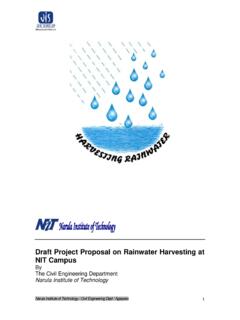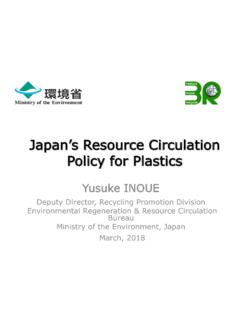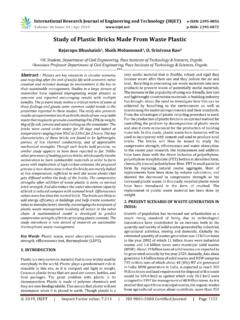Transcription of Bamboo: Green Construction Material
1 Bamboo: Green Construction Material Case Study Bamboo New industrial application and modern Construction design have both demonstrated bamboo s huge potential. Regulatory Mechanisms putting restrictions on bamboo development. Lack of awareness has been the bottleneck inhibiting bamboo from taking shape in Construction . Focusing on modern technology and financial support can expand bamboo market in Construction . Strengthening institutions and government scheme can proliferate bamboo use in Construction . Bamboo: Green Construction Material Key Messages Case Study Bamboo EXECUTIVE SUMMARY Bamboo belongs to grass family and has been associated with various names such as poor man s timber , Green Gold , Cradle to Coffin because of its various documented applications.
2 Bamboo is widely recognized as highly renewable, fast growing, economic raw Material . Products from bamboo are grouped into industrial use, food products, Construction and structural application, wood substitutes and composites, and cottage and handicraft industry. Bamboo is most abundant in India. India has the huge potential for bamboo with 14 million hectares of bamboo forest area. India is the second largest country in terms of bamboo resources. The yield per hectare of bamboo in India is very low compared to China, Taiwan and Japan which contribute about 80% to the world s bamboo market.
3 In coming years India is expected to face timber shortage in order to meet the housing needs of the increasing population. Moreover, the increased dependency on conventional materials is held responsible for degradation of environment. Both the reasons have led to give a thought on the use of bamboo as a substitute for wood and steel as it is considered as highly renewable and environment friendly Material . Bamboo products (bamboo boards, bamboo veneers, bamboo mat corrugated roofing sheets, etc) due to their physical and mechanical performance in terms of hardness, stability and strength are gaining attention with large opportunities in emerging market.
4 Moreover, bamboo has the capability of mitigating climate change as it restores degraded land, act as carbon sequesters and protects from soil erosion. Technology advancement and initiatives taken up by the central and state government has helped in the development of bamboo in Construction and structural applications. New technologies on jointing, protection and preservation of bamboo has been developed which has increased its durability and quality and opened new areas for bamboo as wood substitute. Traditional bamboo culm used in rural housing can now be transformed into new and innovative bamboo based products with latest technology and can be used in top grade houses in roofing, flooring, doors, windows, etc.
5 Presently India has no export market for bamboo products except an insignificant export of handicrafts products. India has huge potential for bamboo export as it is the second largest country after China in terms of bamboo resources. Bamboo sector has been getting support from various stakeholders that include government sector, private sector, research institutes and financial institutes. These stakeholders are promoting and regulating the use of bamboo in Construction . Initiatives taken up by these stakeholders are helping in strengthening the value chain and creating the market for bamboo use in Construction and structural applications.
6 Policies set up by central and state government for bamboo development has also been responsible in proliferating the use of bamboo in Construction . National Bamboo Mission and National Mission on Bamboo application are playing major role both at central and state level. These missions are supporting Case Study Bamboo the activities taken up at state level for bamboo development in Construction . State level missions have been set up in order to enhance the bamboo sector in the respective states. Despite of these initiatives bamboo is not being utilized much in Construction sector as there is a huge demand and supply gap for bamboo raw Material for its industry.
7 Majority of the bamboo is supplied to the paper and pulp industry because of increased demand after which very little is left for consumption by other industry. Moreover, the regulatory mechanisms in India impose restriction on transit and harvesting of bamboo which has a negative impact on the bamboo Construction industry. This case study will present the constraints in the growth of the industry such as regulatory restrictions, supply of raw materials, quality of bamboo, untrained labor, lack of financial support, policy support and implementation, establishment of database, etc.
8 Contents 1. INTRODUCTION .. 1 Bamboo and its Uses .. 1 Use of Bamboo in Construction .. 1 Bamboo and its Characteristics .. 3 Bamboo Resources and Potential in India .. 4 Worldwide Bamboo Resources .. 4 Bamboo Resources in India .. 5 Potential in India .. 5 Need for Bamboo .. 7 2. MAJOR 8 Government .. 8 National Level .. 8 State Level .. 10 Supporting Institutes .. 10 Research Institutes .. 10 Financial Institutes .. 12 Civil Society .. 13 Private Sector .. 13 Collectors and Aggregators .. 13 Consumers .. 14 3. POLICY INITIATIVES: GOVERNMENT MISSION AND POLICIES .. 14 National Level.
9 14 State Level .. 15 4. CATALYSTS AND CONSTRAINTS IN BAMBOO DEVELOPMENT .. 18 5. CONCLUSION .. 23 Draft Case Study Bamboo 1 1. INTRODUCTION Bamboo which is considered as the poor man s timber is one of the most important forestry species with wide distribution throughout India. India has the largest area and second largest reserves of bamboo in the world today, yet its industries are swinging in shortage of raw Material availability. The bamboo economy of the country is still in nascent stage that is 4% of the global bamboo economy (Ombir Singh, 2008).
10 Major consumers of bamboo in the country include paper industry, Construction sector, handicrafts and small and cottage industries. Bamboo and its Uses Bamboo has more than 1,500 documented uses, ranging from fuelwood to light bulbs, medicine, poison and toys to aircraft manufacturing (Forest Research Institute, 2008). The products made from bamboo can be broadly classified into: Industrial Use and Products, (paper and pulp, bamboo charcoal for fuel, bamboo based gasifier for electricity) Food Products (consumption of bamboo shoots) Construction and Structural Applications (Bamboo housing) Wood Substitutes and Composites (Bamboo based panels, Veneers, Bamboo Flooring, mat boards, fiberboards, particle boards, medium density boards, combinations of these, and combinations of these with wood and other ligno-cellulose materials and inorganic substances).







